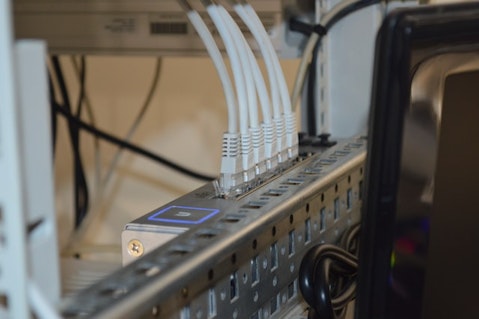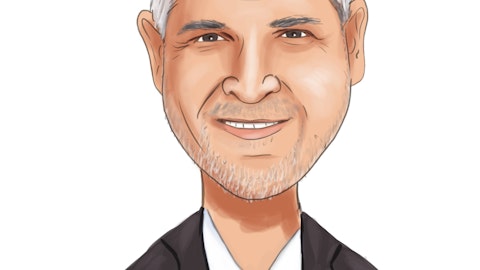Clearfield, Inc. (NASDAQ:CLFD) Q1 2023 Earnings Call Transcript February 2, 2023
Operator: Good afternoon and welcome to Clearfield’s Fiscal First Quarter 2023 Earnings Conference Call. My name is Paul, and I will be your operator this afternoon. I will now pass the call over to Jackie Keshner from Gateway Group.
Jackie Keshner: Thank you. Please note that during this call, management will be making Forward-Looking Statements regarding future events and the future financial performance of the Company. These forward-looking statements are subject to risks and uncertainties that could cause actual results to differ materially from those in the forward-looking statements. It is important to note also that the company undertakes no obligation to update such statements, except as required by law. The Company cautions you to consider risk factors that could cause actual results to differ materially from those in the Forward-Looking Statements contained in today’s press release, Field Report, and in this conference call. The Risk Factors section in Clearfield’s most recent Form 10-Q filing with the Securities and Exchange Commission and its subsequent filings on Form 10-Q, provide description of those risks.
As a reminder, the slides in this presentation are controlled by you, the listener. Please advance forward through the presentation as the speaker presents their remarks. With that, I would like to turn the call over to Clearfield’s President and CEO, Cheri Beranek. Cheri.
Cheri Beranek: Good afternoon, everyone and thank you joining us today. It is a pleasure to speak with our new and returning investor and analysts this afternoon to share Clearfield’s results for the first quarter fiscal 2023 as well as provide an update on our business and current market trends. Our strong financial performance in the first quarter of fiscal 2023 reflects our ongoing execution on our strategic growth plan, as well as the robust and sustained demand for high speed broadband. Total net sales for the first quarter were $86 million, which includes an $8 million contribution from Nestor Cables. Our organic net sales growth continues to be driven by our leadership and community broadband, an expansion across each of our core end markets.
As we continue to execute on our lead strategic plan, we aim to strengthen our existing competitive advantages as we build a scale necessary to serve the long-term demand runway for high speed broadband in unserved and underserved communities nationwide. Based upon consideration of the expected investments and impact of our progress on our leads strategic plan, as well as our ability to manage countervailing headwinds that could develop the customer ordering patterns and components sourcing, we are reiterating our previously stated revenue guidance for fiscal year 2023. In addition, we are introducing 2023 net income guidance of $4.30 to $4.50 a share. Before I review our performance and current market dynamics in greater detail, I would like to briefly introduce you to who we are and what we do for those of you who may be new to Clearfield and our industry.
Clearfield is a leader in the expanding fiber broadband industry. Our goal and underlying value proposition is to enable the lifestyle and better broadband provide. We provide craft friendly fiber protection, fiber management and fiber delivery solutions that enable rapid cost effective fiber fed deployments throughout the broadband service provider space. Our primary end market is community broadband, which is predominantly comprised of Tier 2 and Tier 3 incumbent local exchange carriers and an increasing number of municipalities, utilities, co-ops and wireless carriers. We also serve service providers in the Tier 1 national carrier market, and multiple system cable TV operators or MSOs as well as some international service providers. Pictures on Slide 4 is the Clearfield consent, which has changed the rules of fiber management.
This integrated fiber management system is based on multiples of 12 fibers and can be utilized whenever and wherever it is required in the network. Our FieldShield platform offers protected pathways and fiber options that suit the needs of any network deployment. Our entire product line was thoughtfully designed to be craft friendly in the field, reducing both the amount of necessary skilled labor needed for installation and the level of skilled required to install. This enables our customers to complete their deployments faster and more efficiently, accelerating their time to revenue. With these capabilities, and the competitive advantages we have summarized on Slide 5, we have expanded our market leadership in underserved world broadband.
To further enhance our positioning, we have worked to improve our product delivery lead times, which represented another key area of industry leadership for Clearfield before the COVID-19 pandemic. Across our industry, pandemic fueled supply constraints, held fiber lead times to a range of 10-months to 12-months. By contrast, Clearfield is now targeting lead times within the range of eight-weeks to 10-weeks. I’m proud to say that, we have already achieved these lead times within the range for all product lines with the exception of active cabinets, which have been negatively impacted by the longer lead times associated with power conditioning sub components used in their manufacturing process. This work to improve our lead times comes as our customer ordering cycles return to pre-COVID patterns, but at post-COVID volumes.
Over the past three years, our customers ordered products early in their deployment schedules to stay ahead of any supply chain challenges, as they plan their fiber bills. These advanced orders led to growth in our backlog, which reached record levels by the end of fiscal year 2022. Our customers have moved to staging less equipment in their yards and have now begun ordering according to more normalized, seasonally driven deployment schedules. We believe this trend will continue in 2023 as customers readjust their ordering planning to our improved product lead times, and try to match their order timing to their deployment schedules. Consistent with the return of this traditional ordering and delivery patterns, we anticipate approximately 40% of our expected revenue in the first six-months of our fiscal year and 60% in the second half.
We believe long-term demand remains exceptionally strong. Nearly all of our customers are indicating an increase in the number of homes they are passing and connecting in comparison to the previous year. In addition, the increase in the number of service providers we serve is exciting. For some additional insights on what we are seeing in the market and the significant long-term growth runway for fiber deployments, I would like to welcome our Chief Marketing Officer, Kevin Morgan, to the call. Kevin.
Kevin Morgan: Thank you, Cheri. It is great to be joining all of you this afternoon. The appetite for high-speed broadband communications has never been greater and shows no sign of letting up. This continues to drive fiber deployments deeper into every corner of society and across all market segments. As Cheri mentioned, we believe our work to maintain our world class lead times and further progress, our elite strategic plan enhances opposition for the robust near-term demand environment. On Slide 6, we have also included the fiber broadband association’s strong forecast for power deployments over the next decade. In its 2022 fiber provider survey, published in December, the Fiber Broadband Association estimated a 10-year annual average run rate of 11.3 million fiber deployments.
In 2022 alone, fiber providers passed 7.9 million additional homes, representing a new record for annual deployment. This momentum gives us a powerful foundation for 2023 and the years ahead. As you will see in the accompanying chart, or position within an accelerating investment cycle that has yet to reach its peak. We continue to view the gradual disbursement of ARPA and RDOF funds and the upcoming distribution of BEAD funding as meaningful but gradual industry tailwinds further expand our market opportunity. The data indicated on this slide assumes that 12.3 million new housing units will come online over the next 10-years. Further 92% of homes are expected to have fiber availability, with an additional 34% of homes having two or more available fiber connections.
As this market continues to expand, we believe our craft friendly products will continue to play a vital role in translating homes past numbers in homes connected revenue for our service providers as they deepen their fiber deployments. Turning back to Clearfield fiscal first quarter performance. I would now like to pass the call over to our CFO, Dan Herzog, who will walk us through our financial results for the fiscal first quarter of 2023.
Daniel Herzog: Thank you, Kevin. Good afternoon, everyone. It is a pleasure to be speaking with you today about our fiscal first quarter 2023 results. So looking at our fiscal first quarter 2023 results in more detail. Consolidated net sales in the first quarter of fiscal 2023 were $86 million, a 68% increase from $51 million in the same year-ago period, and down 10% from $95 million in our fourth quarter of 2022. This figure includes $78 million from organic Clearfield and an $8 million contribution from Nestor Cables, representing Nestor’s first full quarter of contributions since we acquired the business on July 26, 2022. The increase in net sales was due to higher sales across our core end markets, particularly in our community broadband, multiple system operator and national carrier markets consistent with our performance throughout fiscal year 2022.

Photo by Thomas Jensen on Unsplash
We recorded a 34% year-over-year increase in our sales order backlog. Order backlog was $136 million on December 31, 2022, up from $101 million on December 31, 2021 and down from $165 million on September 30, 2022. We believe our lead time progress will remain a more meaningful measure of our operational performance going forward. Accordingly, we will focus on this metric in lieu of reporting on backlog in future quarters. I will not review net sales by our key markets. Sales to our primary market community broadband comprised 55% of our net sales in the first quarter of fiscal 2023. In Q1, we generated net sales of approximately $48 million in community broadband, up 33% from the same period last year. In addition for the trailing 12-months ended on December 31, 2022, our community broadband market net sales totaled approximately $192 million, which was up 69% from the comparable period last year.
Our MSO business comprise 25% of our net sales in the first quarter of fiscal 2023. Momentum in the MSO market continues to be strong, with net sales growing 137% year-over-year and up 152% for the trailing 12-month period. Net sales in our national carrier market for the first quarter of fiscal 2023 increased 67% year-over-year. On a trailing 12-month basis, net sales in our national carrier market was up 102% from the year-ago period. Net sales in the international market increased 412% year-over-year in the first quarter compared to the same period last year and we are up 126% year-over-year on a trailing 12-month basis due to the acquisition of Nestor Cables, which are included international sales. Gross profit in the first quarter of fiscal 2023 increased 33% to $31 million, or 35.7% of net sales from $23 million or 44.9% of net sales in the same year-ago quarter.
Our gross profit was affected by our investments to increase capacity for additional growth in the coming quarters and years. These investments include the increased facility costs associated with the addition of the company’s new Minnesota and Mexico facilities that came on board late in the second quarter of fiscal 2022 and the continued expansion to outfit these facilities. Company continues its investment in cable manufacturing at its Mexico facility in conjunction with the Nestor Cables acquisition, which is expected to be operational in our second fiscal quarter. Gross profit was also affected by a full quarter of lower gross profit realized in our Nestor Cables cable manufacturing business. The company expects to operate at these gross profit percentage levels for several quarters with improving margins as revenue levels increase later this calendar year.
Operating expenses for the first quarter of fiscal 2023 were $13 million, which were up from $10 million in the same year-ago quarter. In addition to the increase from the first full quarter of Nestor Cables operating expenses in general, increased areas reflects higher compensation costs travel and entertainment, stock compensation and professional fees. As a percentage of net sales, operating expenses for the first quarter of fiscal 2023 was 15% down from 19% in the same year-ago period. Our current OpEx at less than 15% of sales reflects our continued strong operating leverage. Net income in the first quarter of fiscal 2023 increased 37% to $14.3 million from $10.4 million in the same year-ago period, and was down from $17 million in the fourth quarter of fiscal 2022.
As a percentage of net sales, net income for the first quarter of fiscal 2023 was 17% down from 20% in the same year-ago period, and down from 18% in the fourth quarter of fiscal 2022. In terms of our balance sheet, we had $2.2 billion in capital expenditures, mainly to support our expanding capacity and continued with facility build outs, and our inventory balance increased from $82 million to $90 million in the first quarter. While we expect to continue to increase in inventory this year, we do not expect to do so at the same levels as it did during fiscal year 2022 resulting in improved free cash flow in the fiscal year ahead. As a reminder, we did use approximately $16.7 million of our line of credit in July of 2022 to fund the Nestor acquisition and that amount off in the first quarter of fiscal 2023, leaving a zero balance draw on the line.
In addition, we further enhanced our liquidity position through closing an upsized $120 million public offering of our common stock on December 09, 2022. Under the terms of the offering, we sold 1.2 million shares at a public price of $100 per share. Including the underwriter’s full exercise of the option to purchase up to 180000 additional shares we sold a total of 1.38 million shares of common stock at closing for net proceeds of $130.3 million after expenses paid in connection with the offering. The additional capital grants us greater flexibility pursue our longer term growth objectives and be opportunistic as further growth opportunities arise. We can continue investing in our inventory, CapEx, infrastructure and other necessary strategic areas at a larger scale as well as ensure that we have the working capital position to effectively compete for larger customer opportunities.
We appreciate the support of our new and existing shareholders, as we continue to advance our strategic progress. That concludes my prepared remarks for our first quarter fiscal 2023. I will now turn the call back over to Cheri. Cheri.
Cheri Beranek: Thanks for the financial update, Dan. As I mentioned earlier in the call, we have continued to make progress on our new multiyear strategic plan LEAP which is a successor to our previous Now of Age plan. The LEAP plan is our roadmap to how we will scale at the company in order to seize the opportunity Clearfield was built to achieve, how we expect to jump higher, farther and with greater force. With that said, I would like to review our progress on each of our LEAP plans, four tenants, one for each letter. The L is to leverage our decade long excellence in Community Broadband, the market on which we have focused since our founding in 2008. Through our deep understanding of this market and our customer’s base and regional operators, we have proven to be an agile partner that can evolve with a broader market and grow alongside our customers.
Earlier this month, we announced that we have reached to milestone of shipping 50 million fiber ports of our craft friendly, labor light family of Clearfield cassettes, field assemblies and U.S. terminals. The vast majority of these five reports have been deployed throughout the networks of our community broadband customers. Reaching this milestone underscores the success in the fiber broadband market is as much about execution, as it is innovation. To further improving our scale, we are deepening our commitment to providing our customers the products and support they need when they need it to take their fiber broadband networks as far as they can go. Our E is to execute capacity growth in advance of the market opportunity. Building upon our previous strategic work to augment capacity for ongoing growth, we will continue making progress on these enhancements and developing our supply chain partnerships maintain our market leadership.
Having expanded our manufacturing footprint in both Minnesota and Mexico last year, we are leveraging the in-house cable manufacturing capabilities brought by our acquisition of Nestor Cables. Most recently, we are adding another – line in Finland to generate additional revenue and to improve margins from our current facility. This new line will enhance Nestor’s capacities and will allow us to run our manufacturing at a higher and more efficient level. The A in our LEAP plan is to accelerate infrastructure investment. This tenant represents our underlying investment in our organizational infrastructure, as we continue to grow the business and manage our expanding capacity. To support the significant growth we have generated over the last two-years, we focus in investing in our quality teams and systems.
This includes adding supply chain and quality personnel, as well as placing quality engineers earlier in the overall process. As I said in the past, we can grow as fast as our quality systems will allow. Our investments in this area have played a meaningful role in our top-line growth expansion, and we expect them to help facilitate additional progress. More broadly, we may add personnel to our sales, product management, and manufacturing teams as we work to improve lead times. We will also continue to expand Clearfield College to provide online and infield training support as our industry navigates the ongoing shortage of train labor in the market. Finally, the P in LEAP stands for position innovation at the forefront of our value proposition.
To increasing the cadence of our product expansions and emphasizing innovation in our pilot designs, we aim to build upon the craft friendly nature of our products. We will soon be enough to add additional new product in the coming weeks that we believe further enhances our promise on innovation. More to come on that front. We intend to introduce additional fiber management and fiber connectivity solutions that align with federal and state funding program requirements. These will help facilitate swift and streamlined installations for our customers as they extend the depth and breadth of the fiber broadband access in their networks. As our first quarter financial results indicate, we have continued to make strong progress on our strategic plan amid a robust demand environment and fiber fed broadband.
Our operational agility allows us to be flexible in an evolving market and we have built a strong foundation from which to address the long-term demand runway for high speed broadband across our markets. We believe our continued work to leverage our deep expertise in community broadband, enhance our capacity, accelerate our infrastructure investments, and prioritize innovative product design enables us to both address existing demand and prepare for the longer term tailwinds of state and federal funding. With our current visibility into our current pipeline, we are reiterating our previous staff line guidance of estimated revenue of between $380 million to $393 million, representing a 40% to 45% growth rate over fiscal year 2022. In addition, we are introducing fiscal year 2023 net income guidance of $4.30 to $4.50 a share.
We continue to expect our revenues to follow year-over-year seasonal patterns, resulting in expected strong year-over-year growth in the first half of this fiscal year. We remain underway with improving our product lead times as we further improved capacity and reduced order backlog. While we still expect to see higher levels of build activity in the second half of the year, we will closely monitor the availability of labor that our customers need to proceed with their planned network bills. And with that, we are ready to open the call to your questions.
See also 20 Least Populated States in America and 13 Best Value Dividend Stocks to Buy .
Q&A Session
Follow Clearfield Inc. (NASDAQ:CLFD)
Follow Clearfield Inc. (NASDAQ:CLFD)
Operator: Thank you. We will now be conducting a question-and-answer session. Thank you. Our first question is from Paul Silverstein with Cowen and Company. Please proceed with your question.
Paul Silverstein: Cheri and Dan, what do you all expect, what contribution you are expecting from Nestor, in the March quarter? Is it consistent with the eight million, is that in December or is it something meaningfully different than that?
Cheri Beranek: Yes, it is going to go up in the next quarter. I mean, it is important to remember that Nestor is very much affected by the seasonal nature of our business and probably even more so than we are. And so you are going to see the their numbers about 8 million this quarter, it will probably be double that by the summer, and you know, growing second quarter to probably 10, 11, up to as much as 15 in the summer months, and their gross margins are going to be affected significantly by that. So we are going to see gross margins now at about 11%, 11%, 12% by the summer months, we will be up in the high teens, kind of averaging in that middle about 15%. We said, when we acquired the company, that they are a commodity based business, so the gross margin percentage would go down.
But the gross margin dollar contribution would be accretive. This quarter, that wasn’t the case, the because of the down nests of the winter months, but we still continue to expect that accretive nature throughout the year.
Paul Silverstein: Let me get to the real question. So if I take 10 million to 11 million, 10 million for March, that would imply organic, but do the math right? Based upon your 40/60 split your reiteration 380, 393. And what you did the first quarter that would imply organic, somewhere in the neighborhood, if I did the math correctly, 56 million to 61 million, which in turn would translate to 23% decline to 17% decline sequentially? On a year-over-year basis, if I did the math, right, that would imply 5% to as much as 15% growth if you hit those numbers, or Nestor, and for the larger company. That would be deceleration down from over 50% year-over-year, in the December quarter. And I appreciate the return of a more seasonal business pattern.
But I guess I’m trying to understand the dramatic decline in growth, what would drive such a dramatic – well, I appreciate that everyone’s going to go back to more normal order patterns, the backlog was sustainable. But the number suggests a significant collapse and backlog in a very, we can see the numbers but in a very compressed way. And I’m trying to understand the if we look at linearity, including through the 30-days of the current quarter, is business continuing to soften as you go forward in time, or is it more of a stabilization? Let me let you respond.
Cheri Beranek: Thank you, Paul. I think I would call him in alignment in that. We talked about 90-days ago, at the end of the fiscal year that we were going to see for the first time in two years, bookings were going to be less than shipments and that was a result of the world of coming back to your pre-COVID world a way of doing things and ordering patterns. We are going to start into that process. As people are, as our customers align their inventory positions and their forecasts positions in regard to product alongside the labor conditions, we are seeing a bit of a bubble or perhaps even an inventory swell at this point in the market. And so we think it is very much a – it is not a softening of the market and that demand is very high. It is an alignment of what is actually available with labor.





